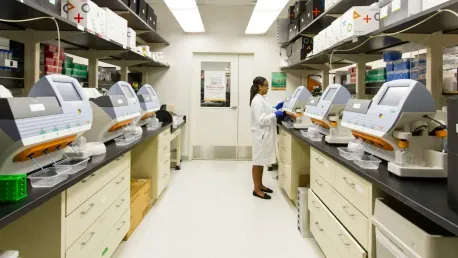The biopharma sector is facing a significant wave of layoffs in 2024, affecting thousands of employees across various companies. This trend is shaped by numerous internal and external factors, including corporate restructuring, market adaptations, strategic divestments, and cost-saving measures. Through this analysis, we delve into the strategic decisions driving these layoffs and the broader industry trends that are reshaping the biopharma landscape.
Corporate Restructuring: Streamlining for Efficiency
Evonik’s Strategic Shift
Evonik is discontinuing its keto acids production in Hanau by the end of 2025. This move, affecting around 260 employees, reflects a broad corporate strategy to concentrate resources on more profitable sectors. By reallocating efforts towards its core growth areas, Evonik aims to enhance operational efficiency and drive innovation where it arguably matters most. The decision is part of Evonik’s larger goal to streamline its business and focus on segments with higher growth and profitability potential.
While the impact on employees is undoubtedly significant, the objective is to foster better overall company performance, thereby ensuring long-term sustainability. This strategic decision aligns with similar corporate restructuring efforts seen across the biopharma industry, where firms are making tough choices to remain competitive. Evonik’s shift highlights the ongoing changes within the sector, as companies adapt their operations to new market realities, focusing more intensively on areas that promise greater returns on investment.
Bayer’s Multiple Layoff Rounds
Bayer is undergoing multiple rounds of layoffs, including significant cuts at its Whippany, NJ headquarters. These layoffs, affecting over 1,500 positions overall and including high-profile executive roles, are part of a wider restructuring initiative. The aim is to streamline operations and reduce redundancy at the management level, thereby creating a more agile organizational structure. Bayer’s extensive restructuring underscores the company’s commitment to enhancing efficiency and agility in a rapidly changing market environment.
The layoffs are also designed to optimize the company’s management structure, cutting costs while maintaining the ability to innovate and compete effectively. By eliminating redundant roles and focusing on core areas of the business, Bayer is positioning itself to better navigate the challenges of the modern biopharma landscape. The company’s actions are emblematic of broader trends in the industry, where restructuring and downsizing are common strategies employed to achieve operational excellence.
Pfizer’s Cost Realignment Program
Pfizer has implemented a global cost realignment program aimed at saving $3.5 billion through layoffs and facility closures. These changes are driven by significant revenue drops for key products. In this context, layoffs are seen as necessary to align the company’s structure with its financial realities and ensure long-term sustainability. The measures reflect a strategic approach to cost management, ensuring that resources are allocated efficiently to sustain the company’s competitive edge.
The cost realignment program is a part of Pfizer’s broader strategy to adapt to changing market demands and financial pressures. By focusing on areas that promise better financial returns and cutting back on less profitable operations, Pfizer is working to safeguard its future in a highly competitive market. The layoffs, though challenging for affected employees, are intended to support the company’s long-term stability and growth.
Shifting Market Demands: Adapting to New Realities
Novavax’s Declining Vaccine Demand
Novavax’s layoffs, impacting around 500 employees globally, are primarily due to weak demand for its COVID-19 vaccine. This shift highlights a broader industry trend of adapting to decreasing demand for pandemic-related products. By cutting jobs, Novavax aims to realign its resources and focus on more promising endeavors. The decline in demand for COVID-19 vaccines underscores a significant shift in the market landscape, prompting biopharma companies to reassess their strategic priorities.
The layoffs at Novavax are a reflection of the company’s efforts to navigate the post-pandemic environment effectively. By reallocating resources to areas with greater growth potential, Novavax is working to maintain its competitive position and foster innovation in other therapeutic areas. The company’s experience illustrates the broader challenges faced by the biopharma sector as it adapts to shifting market demands and evolving healthcare needs.
Boehringer Ingelheim’s Biosimilar Setback
Facing reduced sales of its biosimilar drug Cyltezo, Boehringer Ingelheim has taken steps to downsize its salesforce. This decision reflects a broader pattern of companies adjusting their workforce in response to market performance. The move aims to transition from a fully in-person sales model to a more hybrid approach, thereby optimizing efficiency and customer engagement. Boehringer Ingelheim’s actions are indicative of the broader industry trend toward adopting more flexible and efficient sales strategies.
The shift to a hybrid sales model is designed to better align with market realities and customer preferences, enhancing the company’s ability to compete effectively. By streamlining its salesforce, Boehringer Ingelheim aims to improve operational efficiency and allocate resources more effectively. This strategic realignment underscores the importance of adaptability and innovation in maintaining a competitive edge in a dynamic market environment.
Strategic Divestments and Partnerships: Focusing on Core Areas
Johnson & Johnson’s Layoff Announcements
Johnson & Johnson has announced layoffs affecting 231 employees at its New Brunswick, NJ headquarters. These job cuts, part of a larger restructuring effort, underscore the company’s focus on divesting non-core assets and honing in on high-growth segments. By streamlining operations, Johnson & Johnson aims to bolster its competitive edge in a rapidly evolving market. The layoffs are intended to support the company’s strategic shift toward areas with higher growth potential, ensuring sustained innovation and market leadership.
The decision to cut jobs is part of a broader effort to optimize the company’s portfolio and allocate resources more efficiently. By focusing on its core competencies, Johnson & Johnson is working to enhance its operational efficiency and drive long-term growth. The layoffs, while challenging for affected employees, are a strategic move designed to support the company’s overall business objectives.
Sanofi’s R&D Realignment
Sanofi’s effort to simplify its R&D structure emphasizes a strategic pivot towards immunology. Through pipeline reprioritization, Sanofi seeks to align its research initiatives with long-term goals. Although specific details on layoffs are yet to be announced, the company’s focus on strategic realignment highlights the broader industry trend of concentrating on core competencies. The realignment of Sanofi’s R&D structure reflects a commitment to fostering innovation in high-growth therapeutic areas.
Sanofi’s strategic focus on immunology is designed to leverage the company’s strengths and drive advancements in this critical field. By reprioritizing its research pipeline, Sanofi is working to ensure that its resources are allocated to projects with the highest potential for success. The company’s actions underscore the importance of strategic alignment in maintaining competitiveness in the biopharma sector.
Genentech and Roche’s Product Development Focus
Genentech, under parent company Roche, is cutting approximately 405 positions. This decision follows Roche’s earlier announcement to trim its product development team to refocus on high-growth areas. By realigning its development strategies, Genentech aims to drive innovation while optimizing resource allocation. The layoffs at Genentech are part of a broader effort to streamline operations and enhance the company’s focus on key areas of growth.
The strategic decision to cut jobs at Genentech is intended to support the company’s long-term objectives by ensuring that resources are concentrated on areas with the greatest potential for innovation and market impact. By focusing on high-growth segments, Genentech aims to enhance its competitive edge and drive sustained business performance. The company’s actions highlight the importance of strategic clarity and operational efficiency in achieving long-term success in the biopharma industry.
Cost Reduction Initiatives: Ensuring Financial Health
Bristol Myers Squibb’s Strategic Productivity Initiative
Bristol Myers Squibb is undertaking significant cost-saving measures as part of its Strategic Productivity Initiative. The company plans to cut over 2,200 jobs to achieve $1.5 billion in cost savings by 2025. These layoffs, particularly those in Lawrenceville, NJ, emphasize the need for a leaner and more efficient organizational structure. The cost-saving measures are designed to enhance the company’s financial health and ensure long-term sustainability.
The strategic productivity initiative at Bristol Myers Squibb aims to streamline operations and reduce overhead costs, thereby improving the company’s overall efficiency. By cutting jobs and restructuring its operations, the company is working to align its resources with its business objectives more effectively. The measures reflect a broader trend in the biopharma industry toward cost management and operational optimization.
Thermo Fisher Scientific’s Site Closures
Thermo Fisher Scientific plans to close its Auburn, AL site, impacting 97 employees. This follows the closure of three San Diego sites due to decreased demand for COVID-19 testing kits. These actions are aimed at reducing operational costs and reallocating resources to more lucrative projects. The site closures at Thermo Fisher Scientific are part of a broader effort to enhance financial health and operational efficiency.
As the demand for COVID-19 testing kits diminishes, Thermo Fisher Scientific is adjusting its operations to reflect the new market landscape. By closing less profitable sites and focusing on more promising projects, the company aims to optimize its resource allocation and drive long-term growth. The closures underscore the importance of adaptability and strategic focus in maintaining competitiveness in the biopharma sector.
Emergent BioSolutions’ Focus on Core Products
Emergent BioSolutions is reducing 400 employees as it refocuses on medical countermeasures and its NARCAN Nasal Spray products. These layoffs, combined with other cost-cutting measures, are expected to save over $100 million annually, demonstrating a clear strategy to streamline operations and enhance financial health. The decision to cut jobs at Emergent BioSolutions reflects the company’s commitment to focusing on its core competencies and optimizing its operations.
By aligning its resources with its strategic priorities, Emergent BioSolutions aims to drive innovation and competitiveness in its core areas of focus. The layoffs are part of a broader effort to enhance operational efficiency and ensure long-term business sustainability. The company’s actions highlight the importance of strategic clarity and resource optimization in achieving long-term success in the biopharma industry.
Mergers and Acquisitions: Navigating Organizational Overlaps
The biopharmaceutical sector is poised to experience a significant wave of layoffs in 2024, impacting thousands of employees across a range of companies. This emerging trend is influenced by a combination of internal and external factors, such as corporate restructuring, market adaptations, strategic divestments, and cost-reduction initiatives. Various biopharma firms are undergoing reorganizations to adapt to shifting market dynamics and streamline their operations, often leading to workforce downsizing as they aim to maintain competitiveness and financial stability.
Market adaptations involve companies tweaking their strategies to respond to evolving consumer demands, regulatory changes, and technological advancements. Additionally, strategic divestments, where companies sell off non-core business segments, often lead to job cuts as firms focus on their primary areas of expertise. Cost-saving measures, such as reducing operational expenses, are also driving layoffs, as companies strive to enhance efficiency and meet financial targets.
Through this analysis, we explore the strategic decisions prompting these layoffs and examine the broader industry trends that are reshaping the biopharma landscape. Understanding these factors provides insight into how the sector is evolving and what the future might hold for both companies and employees within this critical industry. Ultimately, these changes underscore the need for agility and adaptability in an ever-changing market.









